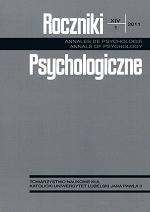W świecie masek, czyli o tym, jak osoby z autyzmem spostrzegają ludzką twarz
In the world full of masks. A study on how people with autism perceive human faces
Author(s): Piotr Jaśkowski, Monika DekowskaSubject(s): Psychology
Published by: Towarzystwo Naukowe KUL & Katolicki Uniwersytet Lubelski Jana Pawła II
Keywords: face perception; emotion perception; autistic spectrum disorder (ASD); fusiform face area (FFA); amygdala (AMY); brain neuroimaging techniques; event-related potentials (ERP); cog-nitive theories of autism
Summary/Abstract: The human face is one of the major stimuli of social nature. With its rapid and effective analysis we are able to make judgments about people’s physical attractiveness, moods, certain personality traits, mental states, intentions and even intelligence. Above all, the correct interpretation of someone’s facial expression determines the success in creating and maintaining a mutually satisfying social contacts. In turn, a deficit of social interaction is one of three main components of autistic spectrum disorders (ASD). This article presents a critical review of recent research on face perception in indi-viduals who suffer from ASD. These recent results suggest atypical face-processing in autistic chil-dren and adults, and also the existence of structural and functional abnormalities in the brain regions responsible for perception of faces and emotions in people with autism. This work is an attempt to interpret an extensive pool of experimental studies presented here in the context of normal face perception development and the two cognitive theories of autism, namely Utah Frith’s Central Coherence Deficit and Simon Baron-Cohen’s Lack of Theory of Mind. The article also indicated new directions for research into the human face perception difficulties among people with ASD.
Journal: Roczniki Psychologiczne
- Issue Year: 14/2011
- Issue No: 1
- Page Range: 91-125
- Page Count: 35
- Language: Polish

